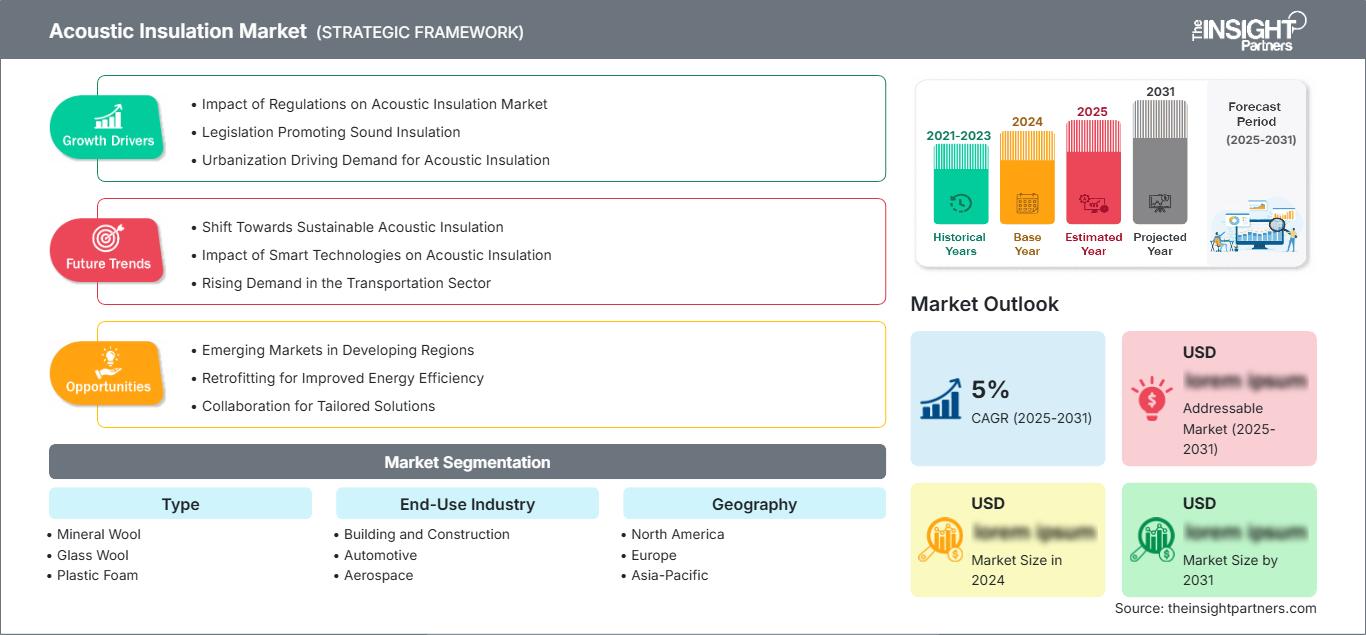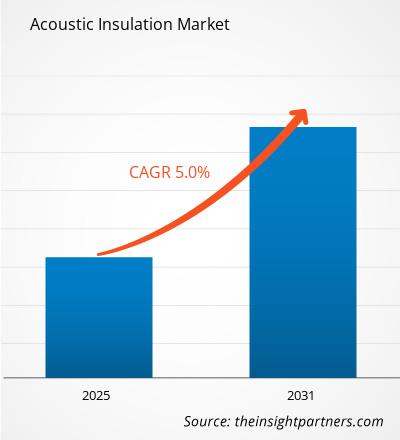Der Markt für Akustikdämmung wird bis 2031 voraussichtlich ein Volumen von 22,68 Milliarden US-Dollar erreichen. Für den Zeitraum 2025–2031 wird ein jährliches Wachstum von 4,8 % erwartet.
Der Bericht zum Markt für Akustikdämmung ist nach Materialtyp (Mineralwolle, Glaswolle, Kunststoffschaum, Elastomerschaum und Sonstige) und nach Endverbraucherbranche (Bauwesen, Automobilindustrie, Luft- und Raumfahrt, Öl und Gas, Energieerzeugung und Sonstige) segmentiert. Die globale Analyse wird zudem auf regionaler Ebene und für wichtige Länder aufgeschlüsselt. Marktgröße und Prognosen auf globaler, regionaler und Länderebene für alle wichtigen Marktsegmente sind im Bericht enthalten. Die Werte für die Analysen, Segmente, Regionen und Länder werden in US-Dollar angegeben. Der Bericht behandelt Markttrends sowie Marktdynamiken wie Treiber, Hemmnisse und wichtige Chancen. Der Bericht umfasst außerdem eine Branchenlandschafts- und Wettbewerbsanalyse mit Fokus auf Marktkonzentration, Heatmap-Analyse, führende Akteure und aktuelle Marktentwicklungen.
Zweck des Berichts
Der Bericht „Markt für Akustikdämmung“ von The Insight Partners beschreibt die aktuelle Marktlage und das zukünftige Wachstum, die wichtigsten Treiber, Herausforderungen und Chancen. Er bietet Einblicke für verschiedene Akteure im Markt, darunter:
- Technologieanbieter/Hersteller: Um die sich entwickelnde Marktdynamik zu verstehen und potenzielle Wachstumschancen zu erkennen, können sie fundierte strategische Entscheidungen treffen.
- Investoren: Um eine umfassende Trendanalyse hinsichtlich Marktwachstumsrate, Finanzprognosen und Chancen entlang der Wertschöpfungskette durchzuführen.
- Regulierungsbehörden: Um Richtlinien zu regulieren und Aktivitäten auf dem Markt zu überwachen, mit dem Ziel, Missbrauch zu minimieren, das Vertrauen der Investoren zu wahren und die Integrität und Stabilität des Marktes zu gewährleisten.
Marktsegmentierung für Akustikdämmung Typ
- Mineralwolle
- Glaswolle
- Kunststoffschaum
- Elastomerschaum
Endverbrauchsbranche
- Bauwesen
- Automobilindustrie
- Luft- und Raumfahrt
- Öl und Gas
- Energieerzeugung
Sie erhalten kostenlos Anpassungen an jedem Bericht, einschließlich Teilen dieses Berichts oder einer Analyse auf Länderebene, eines Excel-Datenpakets sowie tolle Angebote und Rabatte für Start-ups und Universitäten.
Markt für Schalldämmung: Strategische Einblicke

- Holen Sie sich die wichtigsten Markttrends aus diesem Bericht.Dieses KOSTENLOSE Beispiel umfasst Datenanalysen, die von Markttrends bis hin zu Schätzungen und Prognosen reichen.
Wachstumstreiber des Marktes für Schalldämmung
- Auswirkungen von Vorschriften auf den Markt für Schalldämmung: Die globale Bauindustrie sieht sich aufgrund des Bedarfs an verbesserter Schalldämmung von Gebäuden in allen Ländern mit verstärkten Vorschriften und Richtlinien konfrontiert. Beispielsweise wurden in vielen Ländern Gesetze erlassen, die die akustische Leistung von Bauherren und die Errichtung von Gebäuden vorschreiben und durchsetzen, insbesondere in lärmbelasteten Regionen.
- Gesetzgebung zur Förderung der Schalldämmung: Die Gesetzgebung verbessert die Lebensqualität der Bevölkerung und verpflichtet Architekten und Bauherren zur Verwendung bestimmter Schalldämmstoffe, wodurch ein Markt für diese Materialien entsteht.
- Urbanisierung treibt die Nachfrage nach Schalldämmung an: Einer der Faktoren, der das Wachstum des Marktes für Schalldämmung beschleunigt hat, ist die rasante Urbanisierung, insbesondere in vielen Ländern weltweit. Da immer mehr Menschen in städtische Gebiete ziehen, steigt auch der Bedarf an ausreichendem Wohnraum, Büroflächen und anderen sozialen Einrichtungen. Der damit einhergehende Bauboom hat zu einem verstärkten Einsatz von Schallschutzmaterialien und -verfahren geführt.
Zukunftstrends im Markt für Schalldämmung
- Wechsel hin zu nachhaltiger Schalldämmung: Der Markt für Schalldämmung befindet sich im Wandel, da die Branche verstärkt auf nachhaltige und umweltfreundliche Materialien setzt. Angesichts des wachsenden Umweltbewusstseins von Verbrauchern und Unternehmen ziehen Hersteller den Einsatz von recycelten und umweltfreundlichen Materialien in ihren Akustikprodukten in Betracht.
- Auswirkungen intelligenter Technologien auf die Schalldämmung: Der Einsatz intelligenter Technologien im Gebäudedesign wird die Schalldämmung grundlegend verändern. Intelligente Sensoren und andere Systeme können den Lärmpegel in Gebäuden präzise steuern und Schalldämmsysteme bei Bedarf anpassen. Steigende Nachfrage im Transportsektor: Auch im Transportsektor dürfte der Einsatz von Schalldämmstoffen zunehmen, insbesondere aufgrund des wachsenden Trends zu Elektrofahrzeugen und der Wiederbelebung des öffentlichen Nahverkehrs. Darüber hinaus investieren die Bahn- und Luftfahrtbranche in moderne Lärmschutzsysteme, um die Lärmbelastung der Umwelt zu reduzieren. Dies eröffnet neuen Anbietern von Schalldämmprodukten neue Möglichkeiten. Wachstumsmärkte in Entwicklungsländern: Die Bauindustrie in Entwicklungsländern, vor allem im asiatisch-pazifischen Raum und in Afrika, entwickelt sich zu Schlüsselmärkten für Unternehmen der Schalldämmungsbranche. Dies ist auf die Infrastrukturentwicklungspläne und die Urbanisierung in diesen Regionen zurückzuführen. Daher wird für den Markt für Schalldämmung ein deutliches Wachstum erwartet. Nachrüstung für verbesserte Energieeffizienz: Die Nachrüstung bestehender Gebäude zur Steigerung der Energieeffizienz rückt immer stärker in den Fokus und eröffnet damit ein erhebliches Potenzial für Akustikdämmprodukte. Da die meisten Hausbesitzer und Unternehmen den Zustand ihrer Immobilien verbessern möchten, steigert die Installation von Akustiksystemen nicht nur den Wert, sondern auch die Attraktivität der Immobilie. Zusammenarbeit für maßgeschneiderte Lösungen: Die Kooperation zwischen Bauherren, Architekten und Herstellern kann das Angebot an Akustikdämmprodukten erweitern. Spezifische Lösungen für spezifische akustische Herausforderungen in unterschiedlichen Umgebungen – Wohn-, Gewerbe- und Industriegebäuden – können völlig neue Marktsegmente erschließen und einen Wettbewerbsvorteil darstellen.
Markt für Akustikdämmung
Die regionalen Trends und Einflussfaktoren auf den Markt für Schalldämmung im gesamten Prognosezeitraum wurden von den Analysten von The Insight Partners ausführlich erläutert. Dieser Abschnitt behandelt außerdem die Marktsegmente und die geografische Verteilung des Marktes für das Management von Herzrhythmusstörungen in Nordamerika, Europa, Asien-Pazifik, dem Nahen Osten und Afrika sowie Süd- und Mittelamerika.
Umfang des Marktberichts zu Akustikdämmung
Berichtsattribut Einzelheiten Marktgröße in 2024 US$ XX Billion Marktgröße nach 2031 US$ 22.68 Billion Globale CAGR (2025 - 2031) 4.8% Historische Daten 2021-2023 Prognosezeitraum 2025-2031 Abgedeckte Segmente By Typ - Mineralwolle
- Glaswolle
- Kunststoffschaum
- Elastomerschaum
- Bauwesen
- Automobilindustrie
- Luft- und Raumfahrt
- Öl und Gas
- Energieerzeugung
- Nordamerika
- Europa
- Asien-Pazifik
- Süd- und Mittelamerika
- Naher Osten und Afrika
Abgedeckte Regionen und Länder Nordamerika - USA
- Kanada
- Mexiko
- Großbritannien
- Deutschland
- Frankreich
- Russland
- Italien
- Restliches Europa
- China
- Indien
- Japan
- Australien
- Restlicher Asien-Pazifik
- Brasilien
- Argentinien
- Restliches Süd- und Mittelamerika
- Südafrika
- Saudi-Arabien
- Vereinigte Arabische Emirate
- Restlicher Naher Osten und Afrika
Marktführer und wichtige Unternehmensprofile - 3M Co
- Compagnie de Saint-Gobain S.A.
- Armacell
- BASF SE
- Johns Manville
- Knauf Insulation
- The Dow Chemical Company
- Owens Corning
- Paroc Group Oy
Marktdichte im Bereich der Akustikdämmung: Auswirkungen auf die Geschäftsdynamik
Der Markt für Schalldämmung wächst rasant, angetrieben durch die steigende Nachfrage der Endverbraucher. Gründe hierfür sind unter anderem sich wandelnde Verbraucherpräferenzen, technologische Fortschritte und ein wachsendes Bewusstsein für die Vorteile des Produkts. Mit steigender Nachfrage erweitern Unternehmen ihr Angebot, entwickeln innovative Lösungen, um den Kundenbedürfnissen gerecht zu werden, und nutzen neue Trends, was das Marktwachstum zusätzlich beflügelt.

- Holen Sie sich die Markt für Schalldämmung Übersicht der wichtigsten Akteure
Wichtigste Verkaufsargumente
- Umfassende Abdeckung: Der Bericht bietet eine umfassende Analyse der Produkte, Dienstleistungen, Typen und Endnutzer des Marktes für Schalldämmung und vermittelt so ein ganzheitliches Bild.
- Expertenanalyse: Der Bericht basiert auf dem fundierten Wissen von Branchenexperten und Analysten.
- Aktuelle Informationen: Der Bericht gewährleistet Geschäftsrelevanz durch die Berücksichtigung aktueller Informationen und Datentrends.
- Anpassungsmöglichkeiten: Dieser Bericht kann an spezifische Kundenanforderungen angepasst werden und sich optimal in die Geschäftsstrategien integrieren.
Der Forschungsbericht zum Markt für Schalldämmung kann somit maßgeblich dazu beitragen, das Branchenszenario und die Wachstumsaussichten zu entschlüsseln und zu verstehen. Auch wenn einige berechtigte Bedenken bestehen, überwiegen die Vorteile dieses Berichts insgesamt die Nachteile.
- Historische Analyse (2 Jahre), Basisjahr, Prognose (7 Jahre) mit CAGR
- PEST- und SWOT-Analyse
- Marktgröße Wert/Volumen – Global, Regional, Land
- Branchen- und Wettbewerbslandschaft
- Excel-Datensatz
Aktuelle Berichte
Verwandte Berichte
Markt für akustische Wellensensoren Markt für akustische Ingenieurdienstleistungen im Automobilbereich Markt für akustische Rufgeräte Markt für Schallemissionsprüfungen Markt für akustische Absorbermaterialien Markt für HF-Akustikwellenfilter Markt für akustische Massenwellenresonatoren Markt für Schallemissionsgeräte Markt für akustische Materialien Markt für akustische Mikroskopie Markt für Unterwasser-Akustikmodems Markt für bioakustische Sensorik Markt für verteilte akustische Sensorik Markt für Akustikschaumisolierung Markt für akustische Unterwasserkommunikation Markt für akustische Sensoren Markt für akustische Materialien für die Automobilindustrie Markt für Akustikusneurinome Markt für Schalldämmung Markt für photoakustische TomographieErfahrungsberichte
Grund zum Kauf
- Fundierte Entscheidungsfindung
- Marktdynamik verstehen
- Wettbewerbsanalyse
- Kundeneinblicke
- Marktprognosen
- Risikominimierung
- Strategische Planung
- Investitionsbegründung
- Identifizierung neuer Märkte
- Verbesserung von Marketingstrategien
- Steigerung der Betriebseffizienz
- Anpassung an regulatorische Trends




















 Kostenlose Probe anfordern für - Markt für Schalldämmung
Kostenlose Probe anfordern für - Markt für Schalldämmung